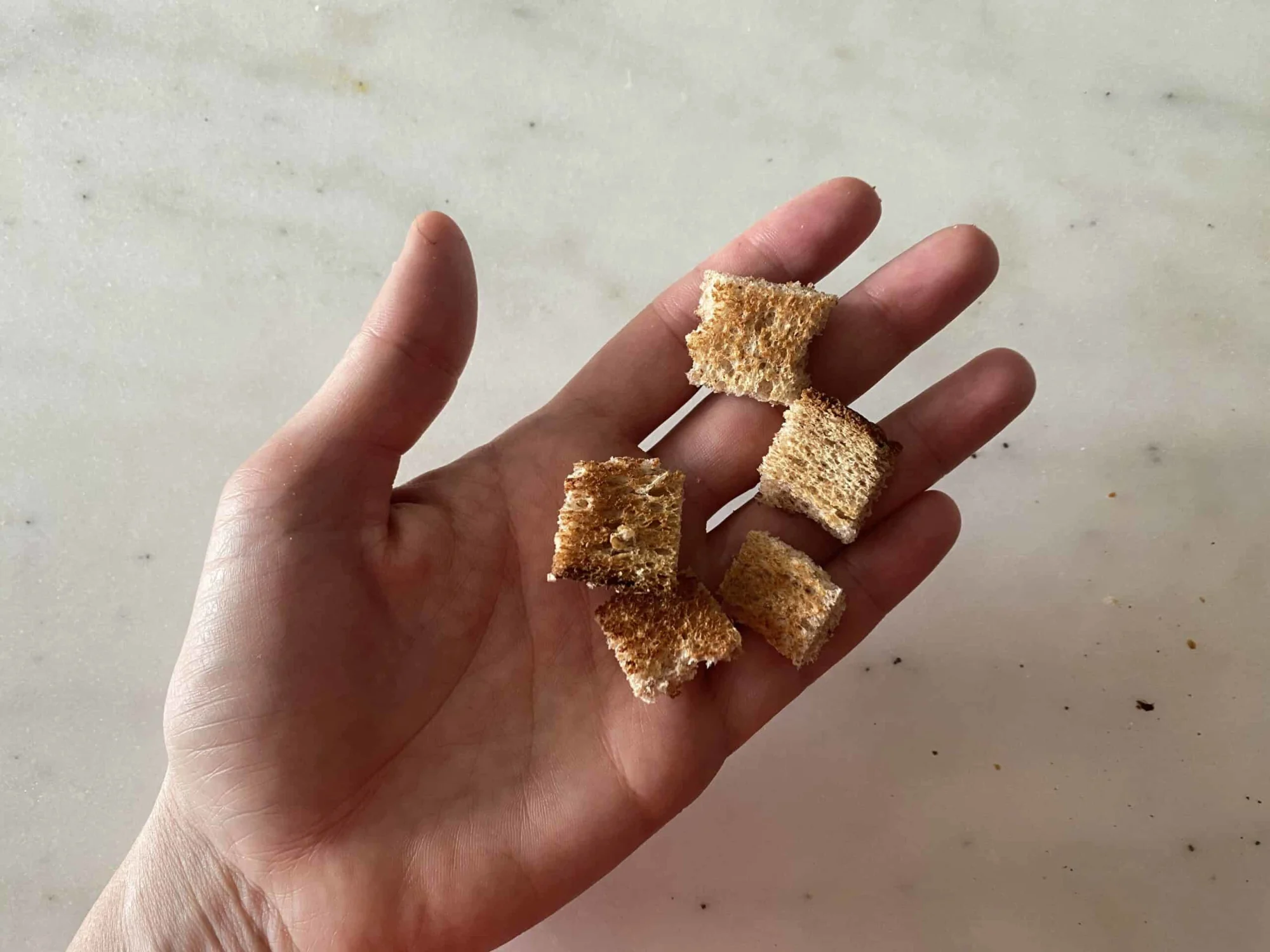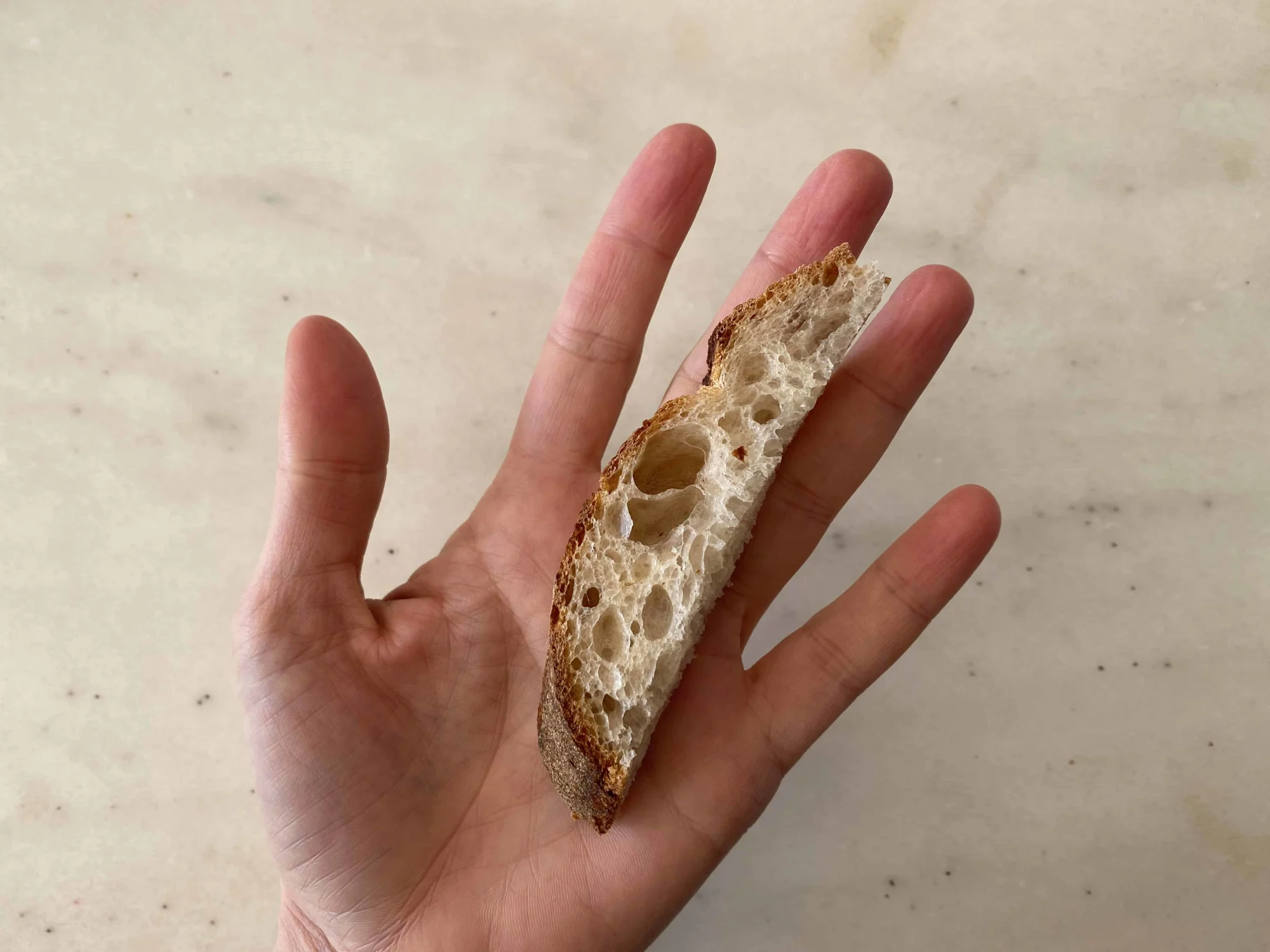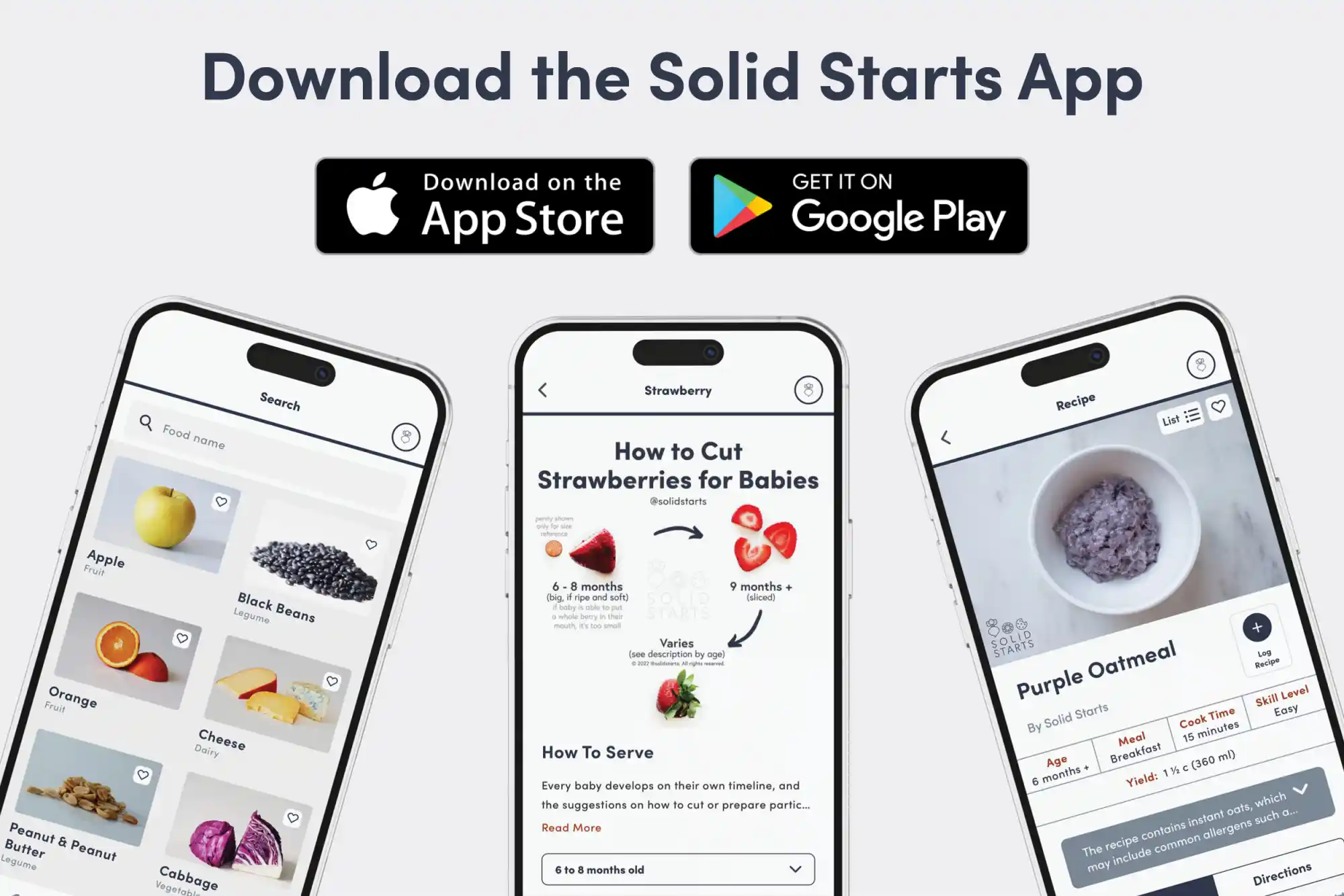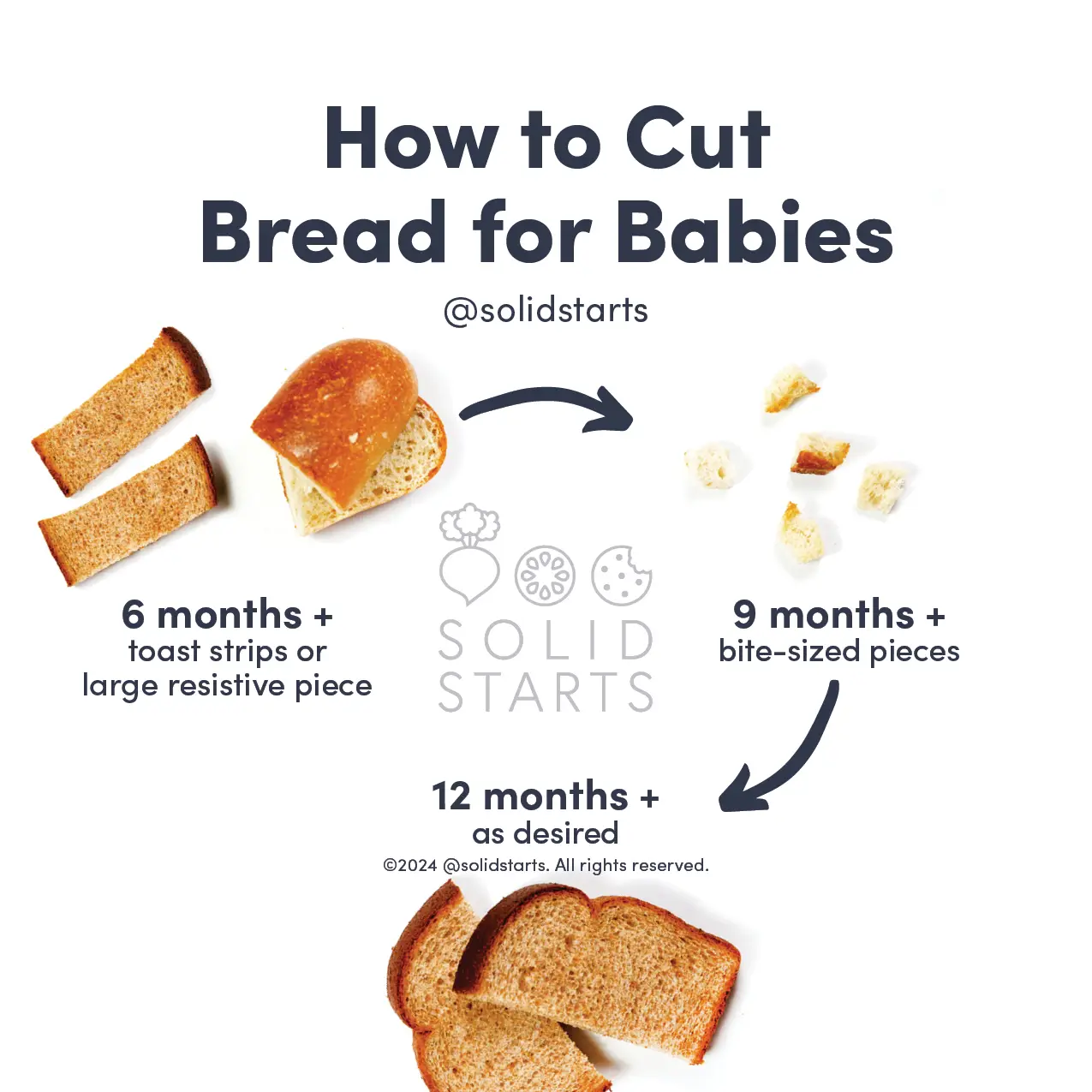
When can babies have bread?
Many types of bread may be introduced as soon as baby is ready to start solids, which is generally around 6 months of age, but take care when serving. Bread is a common choking hazard, and some styles pose a higher risk than others. See our serving suggestions for types of bread that minimize the risk for babies and toddlers. In addition, bread typically contains wheat and other common food allergens, such as cow’s milk, egg, and sesame. When sharing bread with babies under 12 months of age, avoid varieties that contain honey, which is associated with a risk of infant botulism.
For thousands of years, humans have been baking bread by drying and grinding plants into meal, mixing flour with water, and exposing dough to heat. The food’s origin is linked to flatbread—a simple dough cooked quickly on a hot surface. Today, bakers produce hundreds of savory and sweet breads across the world, from Afghani bolani and Chinese laobing, to Indian papadum to Jamaican bammy, to Mexican pan dulce and Nepali sel roti.
Is bread healthy for babies?
Yes. All bread offers plenty of carbohydrates plus some fiber and protein, too. Nutrition varies widely depending on the type of bread, with some offering more nutrients than others. Some breads are fortified with added vitamins and minerals, while others are not.
Which breads are most nutritious for babies?
Most breads are nutritious for babies for a variety of reasons. Bread is typically rich in carbohydrates, which provide fast energy to fuel baby’s growth and activity. Different types can also offer nutrients like B vitamins, iron, and more. Whole grain and sprouted breads typically contain more protein and fiber to help support growth and digestive function, while the nutrients in sourdough bread are more absorbable by the body as a result of being fermented. Even white bread, while commonly regarded as less nutritious, is often fortified with folate and iron, which are important nutrients for baby.
Does bread contain common allergens?
Yes. Bread often contains common food allergens like cow’s milk, egg, sesame, and wheat. Read labels closely and wait to introduce bread until all common allergens on the ingredient list have been safely introduced.
Wheat (alongside other gluten-containing cereals grains) is classified as a global priority allergen by the World Health Organization. Wheat is one of the most common food allergens in children. Fortunately, two-thirds of children outgrow the allergy by their 12th birthday.
It is important to note that wheat allergy is not the same as celiac disease. While a wheat allergy may be outgrown, celiac disease requires a strict, lifelong gluten-free diet and lifestyle. A gluten “allergy” is typically a misnomer, often in reference to celiac disease.
While rare, some individuals have a condition known as wheat-dependent, exercise-induced anaphylaxis, which can result in a severe allergic reaction if the person exercises within a few hours after eating wheat. These patients should avoid eating wheat in the four hours before strenuous activity.
Lastly, individuals with Oral Allergy Syndrome (also known as pollen food allergy syndrome) may be sensitive to wheat, particularly those who are allergic to grass pollen. Oral Allergy Syndrome typically results in short-lived itching, tingling, or burning in the mouth, and can also result in gastrointestinal distress (abdominal pain, cramping, bloating, or diarrhea) in some cases - especially if the grain was not properly digested and the proteins reach the lower GI tract intact. While uncomfortable, it is unlikely to result in a dangerous reaction.
If you suspect baby is allergic to wheat, talk to a pediatric health care provider before introducing bread at home. As you would when introducing any new food, start by offering a small quantity for the first few servings and watch closely for any signs of an allergic reaction. If there is no adverse reaction, gradually increase the amount over future servings.
Is bread a choking hazard for babies?
Yes. Both very soft breads and very hard, cracker-like breads have qualities that increase choking risk, as well as breads with high-risk foods baked into them. Cracker-like breads and breads with dried fruit, nut pieces, and large seeds are among the common choking hazards for young children. Additionally, soft breads like brioche, challah, and deli rolls tend to soften and stick together upon contact with saliva, forming a sticky clump that can cling to the tongue and roof of the mouth and cause gagging. To reduce the risk, prepare and serve bread in an age-appropriate way. As always, make sure to create a safe eating environment and stay within an arm’s reach of baby during mealtime.
Learn the signs of choking and gagging and more about choking first aid in our free guides, Infant Rescue and Toddler Rescue.
Videos
What are the benefits of offering bread to baby?
There are many benefits to offering bread to baby, including development of oral motor skills and expanding baby's experience with diverse foods and flavors. Bread can be terrific for strengthening the jaw and helping baby learn how to bite and tear. Crusty boules, sourdough, baguette, bagel, bialy, ciabatta, filone, flatbreads, ka’ak, pretzel bread, and roti all provide a beneficially challenging texture for new eaters. These breads will be the hardest to consume, so try serving them after baby already has some food in the belly.
Is toast or bread better for babies?
For the youngest babies, toast tends to be safer and easier for a baby to manage in the mouth. Untoasted bread can form a sticky mass in baby’s mouth that is challenging to move around and could form a sticky plug in the airway leading to choking.
Can babies eat gluten?
Yes, as long as a child does not have celiac disease, non-celiac gluten sensitivity, or wheat allergy. Read more in our Celiac FAQ.
Gluten is a type of protein in wheat and other grains such as barley, rye, and some oats. Gluten is edible, but it becomes problematic for individuals with celiac disease, an autoimmune disease, characterized by damage of the small intestine when gluten is consumed. Some individuals may be sensitive to gluten but may not have an allergy or celiac disease. In some cases, this may be non-celiac gluten sensitivity. Talk to a health care provider if you are concerned about issues related to gluten and digestion.
When can babies have bagels?
Bagels may be introduced as soon as baby is ready to start solids, which is generally around 6 months of age, as long as they are free of honey, which is associated with a risk of infant botulism. To minimize choking risk, toast the bagel and cut one half into a half-moon shape. Avoid styles that contain nut pieces, large whole seeds, or dried fruit like raisins, which pose a higher choking risk for young children. Note that bagels often contain common food allergens, (for example dairy, egg, sesame, soy, tree nut, and wheat) so read labels carefully and wait to offer bagels until all common food allergens are safely introduced. Finally, keep in mind that bagels are hard to tear and chew, so for babies under 12 months of age, a toasted bagel will be more of a tool for building eating skills and a food teether than a food to fill the belly. To offer more opportunities for consumption in the meal, try serving a toasted bagel with a soft, spreadable dip like labneh, ricotta cheese, thinned out nut or seed butters, whipped cream cheese, or yogurt.
When can babies have flatbreads?
It depends on the type. While crispy, cracker-like flatbreads are best reserved for older toddlers, soft flatbreads may be offered as soon as baby is ready for solids, which is generally around 6 months of age. That said, certain types, like injera, roti, wheat tortillas, and others may get gummy in baby's mouth. Try lightly toasting these flatbreads to make them firmer and less likely to soften and stick in the mouth or consider waiting to share once a child has more developed eating skills, which typically happens around the first birthday. For babies who are still learning how to pick up food, try rolling soft flatbreads into a stick shape, which is easier for baby to grab and hold. Note that flatbreads often contain common food allergens, (for example dairy, egg, sesame, soy, tree nut, and wheat) so read labels carefully and wait to offer until all common food allergens are safely introduced.
How much bread can babies and toddlers have in a day?
There is no defined amount of bread that a baby or toddler can have in a day. How much food a child eats, including bread, can depend on a child’s age, appetite, family practices, and individual needs. Some days, a child may eat more bread, other days, they may consume less. Both of these scenarios are completely normal.
Toddlers and young children sometimes love bread so much that they fill up on it, which lowers their interest in other foods to nourish their developing bodies. The goal is to continue to offer a variety of foods, in addition to bread. If it is hard to engage a toddler in food that is not bread, it can help to offer other parts of the meal before bringing bread to the table.
What are the healthiest breads for toddlers?
Most breads offer various health benefits for toddlers. Bread is typically rich in carbohydrates to fuel a toddler’s energy. Some breads are more nutrient-dense than others. For example, whole grain breads typically contain more fiber to support digestive function. Ultimately, the healthiest bread for toddlers is one that is accessible, nourishes their body with energy and satisfaction, and connects them to their family's food culture.
How do you serve bread to babies?
Every baby develops on their own timeline, and the suggestions on how to cut or prepare particular foods are generalizations for a broad audience.
6 months old +:
Serve bread that holds its shape as baby munches, such as the large heel of a thick, crusty loaf or well-toasted bread cut into strips about the size of two adult fingers pressed together. Bread that has some resistance stands up to the powerful suck and grip of a baby at this age, and it also offers valuable opportunities for biting and tearing practice. These styles and shapes also pose a lower risk than cracker-like breads, which are sharp, and very soft breads, which become gummy and sticky upon contact with saliva and can cause more gagging. To further minimize choking risk, avoid breads with candied citrus, dried fruit, nut pieces, or large whole seeds. When sharing bread with babies under 12 months of age, avoid varieties that contain honey, which is associated with a risk of infant botulism.
If you would like to share soft breads like brioche, challah, or pre-sliced sandwich breads, serve them in toasted strips to make their texture easier for baby to manage in the mouth. Feel free to add a soft spread like mashed avocado, fresh ricotta cheese, hummus, or yogurt. You can also thin out a smooth nut or seed butter and spread it very thinly on the toast strips. As baby munches, bread may break apart, and if any piece makes you nervous, simply remove it from the child’s eating area and replace it with something else. If a large piece breaks off in baby’s mouth and they are struggling to manage it, you can try encouraging them to spit the piece out.
9 months old +:
Continue with toasted bread strips or large pieces of firm bread that baby can hold and munch on without pieces cracking or breaking off, such as a pizza crust or heel of a baguette, country loaf, or sourdough bread. You can also serve bite-sized pieces of toast if baby has a working pincer grasp (where the thumb and pointer finger meet to pick up smaller pieces of food). If baby tends to shovel too many pieces of bread in the mouth, offer one piece at a time. To ease swallowing, try spreading with a soft mash like avocado, beans, fresh ricotta cheese, or yogurt. You can also thin out a smooth nut or seed butter and spread it very thinly on toast. Avoid bread that contains choking hazards like candied citrus, dried fruit, nut pieces, or large whole seeds. When sharing bread with babies under 12 months of age, avoid varieties that contain honey, which is associated with a risk of infant botulism.
12 months old +:
Explore a wide variety of breads for biting, tearing, and chewing practice. Offer a whole slice of bread or cut the slice into halves or quarters, either toasted or untoasted. If the toddler has not had a lot of experience with bread by this age, continue to toast the bread, which makes it easier for a newer eater to move around in the mouth. For toddlers with more experience managing harder-to-chew foods, try serving slices of soft breads like brioche or challah. When you are feeling confident in the child’s chewing skills, offer bread or toast spread with a thin layer of nut or seed butter. Keep in mind that moist, sticky bread and bread spread with nut or seed butters may cause some gagging as the child practices moving the hard-to-chew food around in the mouth. If a child routinely overstuffs their mouth with food, offer breads with a more resistive texture, or serve fewer small pieces at a time.
18 months old +:
Serve bread as desired, including as sandwiches. Toddlers often like to take apart a sandwich to explore what’s inside and eat the different components separately, although some children are interested in holding a sandwich together at this age. For children who are not used to eating food with mixed textures, supervise closely as they figure out how to manage the different textures in one bite. You can also begin offering breads that contain candied citrus, dried fruit, and large whole seeds as a toddler’s chewing skills improve.



How often should you offer solids? See our sample feeding schedules for babies of every age.
Our Team
Written by
Expert Tips Delivered to Your Inbox
Sign up for weekly tips, recipes and more!
Copyright © 2024 • Solid Starts Inc








